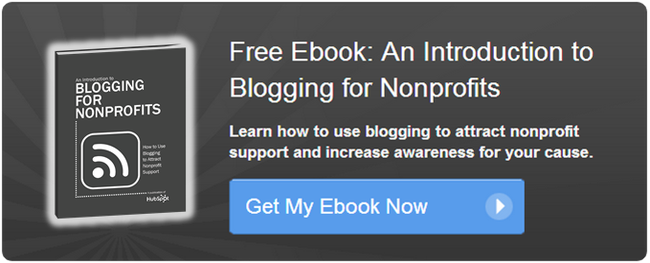One of the most effective ways to tell the story of your nonprofit, its constituents, and staff members is through a blog. Storytelling about your nonprofit allows you to leveraging these human stories to connect individuals to your cause and inspire them support your organization -- and connect you to a wider audience online.
But there are a few key aspects of a nonprofit blog that make the great stand out from the average. If you're looking to achieve a best-in-class blog that supports your nonprofit's cause and inspires your readers, here's what your organization should keep in mind when striving for a successful, engaging blog.
1) Provide a two-way street of communication.
Not only does your blog highlight your compelling stories, but it should be a place for communicating with your readers and supporters. Simply asking your audience for their input on a blog post or story creates that dialogue. It helps give a voice to your organization’s staff and reminds your readers that there are actual people on the other end, supporting your mission from the inside. A blog is a great place to discuss issues, share success stories, and garner feedback on your content. It’s also a place for your constituents to communicate with each other.
The ASPCA’s blog is a great example of this communication between followers, supporters, and activists. Just this week, the nonprofit posted a breaking news story about 367 dogs that were rescued from a dog-fighting bust and had over 180 comments on the piece:
2) Tell and share personal stories.
The most powerful blog posts connect the reader emotionally to the story being told -- especially when they’re told via video. charity: water created a touching and inspiring video of 9-year-old Rachel Beckwith, a fundraiser who was tragically killed in a car accident before she reached her fundraising goal. Her story sparked thousands of individuals across the world to donate to her fundraising page in her honor, raising over $1.2 million. Here was how charity: water told Rachel's story -- and made donors feel connected with the nonprofit:
3) Tie donor actions to numbers.
Explaining how a donation directly impacts your organization’s mission is sometimes made easier with numbers. You can tie the donation amount to singular units the way Nothing But Nets does. When someone donates $10, for example, the organization is able to purchase a mosquito net for one child living in a country where malaria and other blood-borne diseases are rampant. Nothing But Nets explained how it works in a recent blog post:
Or, you can show the overall impact of your organization’s fundraisers. In another blog post, St. Baldrick’s posted a photo of the Quinnipiac University Ice Hockey Team in Hamden, Connecticut. Team members raised $25,000 for cancer research by shaving their heads.
Showing the impact of constituents’ support is key to getting people to come back and give again. The more concrete you can make the impact, the easier it is for people to see their impact and give again -- as well as share your organization’s mission or cause with their personal networks.
4) Thank constituents for their volunteer efforts.
If your organization has ways that people can volunteer their time, such as sitting on or chairing a committee, fundraising for your cause, or helping out at events, you can use blog posts to highlight their efforts. By spotlighting your constituents and what they’ve done to help your organization, you get a triple benefit. One, you’re thanking people for their time and effort -- which always goes in delighting your volunteers; two, you inspire others to become involved; and three, when you spotlight people, they naturally tell their friends, family and co-workers through social media and email, which drives even more people back to your blog and spreads awareness instantly.
A great example of this comes from charity: water again. The nonprofit shot a short “We Love Our Supporters” video for Valentine’s Day this year to say thank you and posted it on their blog:
5) Repurpose evergreen content.
You know the frequently asked questions you hear repeatedly -- these are the questions to which you probably already have stock answers. In addition to (or instead of) creating an FAQ page for your website, create blog posts that answer some of these questions, such as, “How can I be a successful fundraiser?” or, “Who should I email my fundraising page to, and how often should I do so?” Or, create a post that explains terms used in your industry or develop a post that lists other resources, bloggers or experts. This type of evergreen content is relatively easy to create and lasts forever – and if it’s optimized, searchers will find it when looking for information over and over again.
The Red Cross’s blog is a great example of this. The nonprofit categorizes all of its posts, including disaster services, health and safety, and services for the armed forces, which are all topics that a large audience will continuously be looking for online. Being the destination for basic facts and helpful information about what your organization is the expert in is a great way to attract a consistent audience.
6) Recruit guest bloggers or hire someone to write for you.
One way to alleviate the pressure of having to write a lot of blog content is to recruit people to help you. You can hire a freelancer or intern to write your blog for you. You can also divide up blog writing duties between your staff -- perhaps assigning one article a month per person, or creating team or department quotas.
In addition, you can recruit guest bloggers -- your constituents, experts in the community, board members, or volunteers. Having guest bloggers is a win-win: You get your constituents’ personal stories and fresh blog content (without having to write it all yourself); your guest bloggers get to relate why they’re connected to your cause or how your organization is helping them battle cancer, save an animal’s life, retrain for a job, etc. As an added bonus, when a guest blogger writes a post, you can bet he or she will share it with his or her network, increasing your organization’s reach and building your credibility.
As a great example of a guest blogger program, Heartwaves (an organization that brings together parents and patients of congenital heart disease) recruited 30 guest bloggers to contribute to their blog community to build credibility and alleviate the pressure of having to write all the content with its small staff.
These are just a few examples of successful nonprofit blogging practices. How does your organization maximize its blog to engage new and current audiences?
Image Credit: tillwe
Blogging




![HubSpot's 2025 State of Blogging Report [Data from 500+ Marketers]](https://53.fs1.hubspotusercontent-na1.net/hubfs/53/untitled-design-4-67880d8b2a3db.webp)






![The Top 3 Reasons Consumers Read Blogs & How to Attract Them [New Data]](https://53.fs1.hubspotusercontent-na1.net/hubfs/53/202_Reasons-Consumers-Read-Blogs.png)
